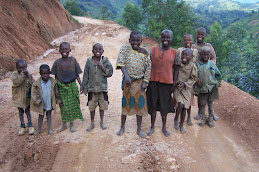Just returned from a holiday in Cuba with Teresa. We had intended to go last Spring, but couldn't get onto a trip, and had to wait until November. (Summer months are the hurricane season, so to be avoided). Those of you reading this who were with me at VSO training at Harborne Hall - this is the reason why I couldn't start my placement in September when you all began!
So what was Cuba like? First of all hot, HOT, HOT! Good training for Rwanda, though. I must make sure I don't let myself get dehydrated, and I have to learn to move more slowly and not charge about like a bull in the proverbial.
Good things about Cuba: the music (everywhere and always competent; even the smallest cafe has its little band and absolutely everyone has a sense of rythm). Watching people dance - so fluid, so transported. The scenery - almost complete lack of adverts (but plenty of political slogans on billboard sized hoardings), litter-free in most places, vivid greens everywhere. The old American cars - they're eveywhere, kept going more by faith than physics. The safety - even in the most run-down parts of Havana we didn't feel threatened (though if I went out on my own I could barely get two blocks before being propositioned by a statuesque young jinetera). Old Havana where the buildings have been restored - high quality restoration. The courtyards inside some of the older colonial style buildings are simply wonderful oases of calm and coolness. Going round a crocodile reserve/farm, then eating crocodile meat for lunch. The aerial ropeway at Las Terrazas eco-resort - in fact just about everything about Las Terrazas from the landscaping of the main hotel to the wonderful vegetarian restaurant and the orchid collection in the botanical gardens.
Grotty things about Cuba: public transport (not that we used it, but literally hundreds of people crammed into the camel-buses in tropical heat must be unbearable). The unrestored buildings in central Havana - literally falling down, though with people still living in them. Turkey vultures - they're everywhere; the first few are interesting, after that they're boring. They gather in flocks of two dozen or more. The waste of land - thousands of acres of fertile land left idle because the combination of world sugar prices, the American blockade and the lack of lateral thinking by national planners means that growing and refining sugar is unprofitable. Pollution from ancient lorries and modern oil refineries or power stations (especially in Cienfuegos).
Here are some pictures which sum up my experience of Cuba:


Once Edouardo, our guide, had sussed that none of our party had links to the secret police, he was amazingly open about the pluses and minuses of life in Cuba. Everybody wanted to sound him out about the big question: what will happen when Fidel dies. His take was that nothing will hapen until Fidel goes. Hopefully, Bush will be gone in the USA and replaced with Clinton or Obama, or other more moderate politicians. The Helms-Burton act, which has imposed a trade embargo to strangle Cuba's trade with the rest of the world, will be lifted. At the point Cuba will change very quickly. Whether it will be corporate America rolling in and swamping everything, or whether Cuba can control America's influence while welcoming its dollars, is a moot point.
One thing is certain: if you want to see the "classic" Cuba, the Cuba of Castro and Che Guevara as it has been for the past 50 years, you need to go as soon as poss!




























